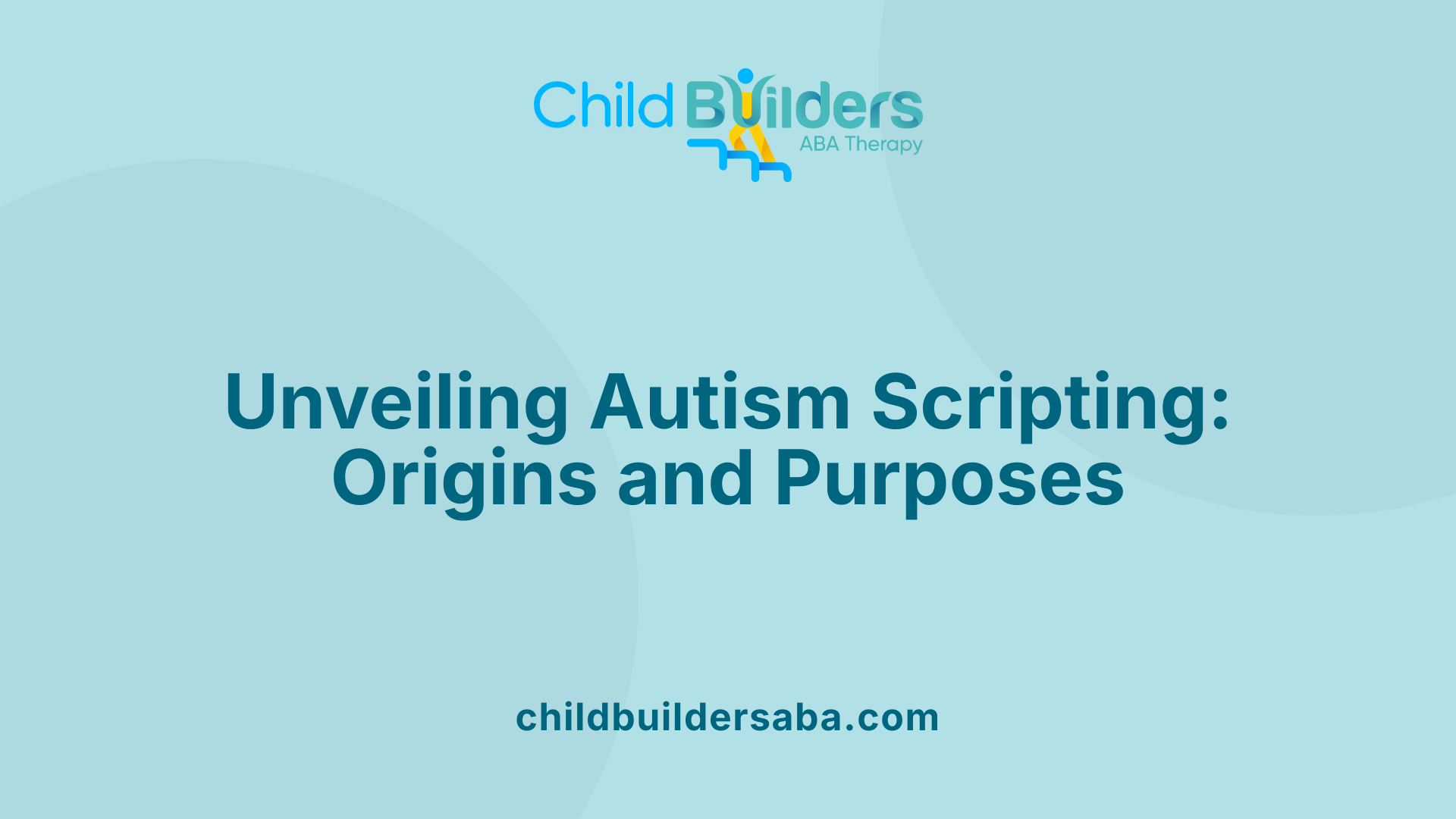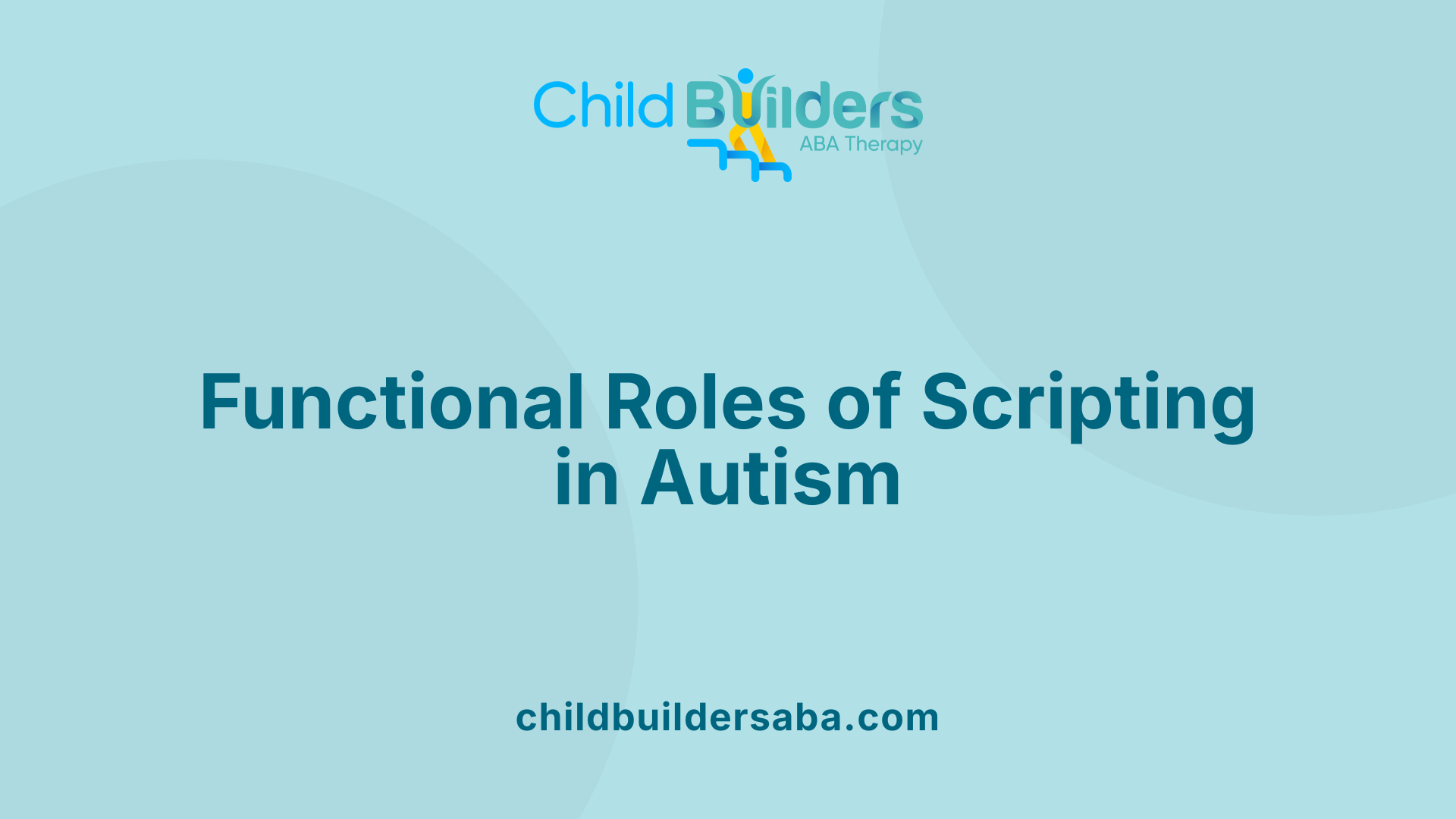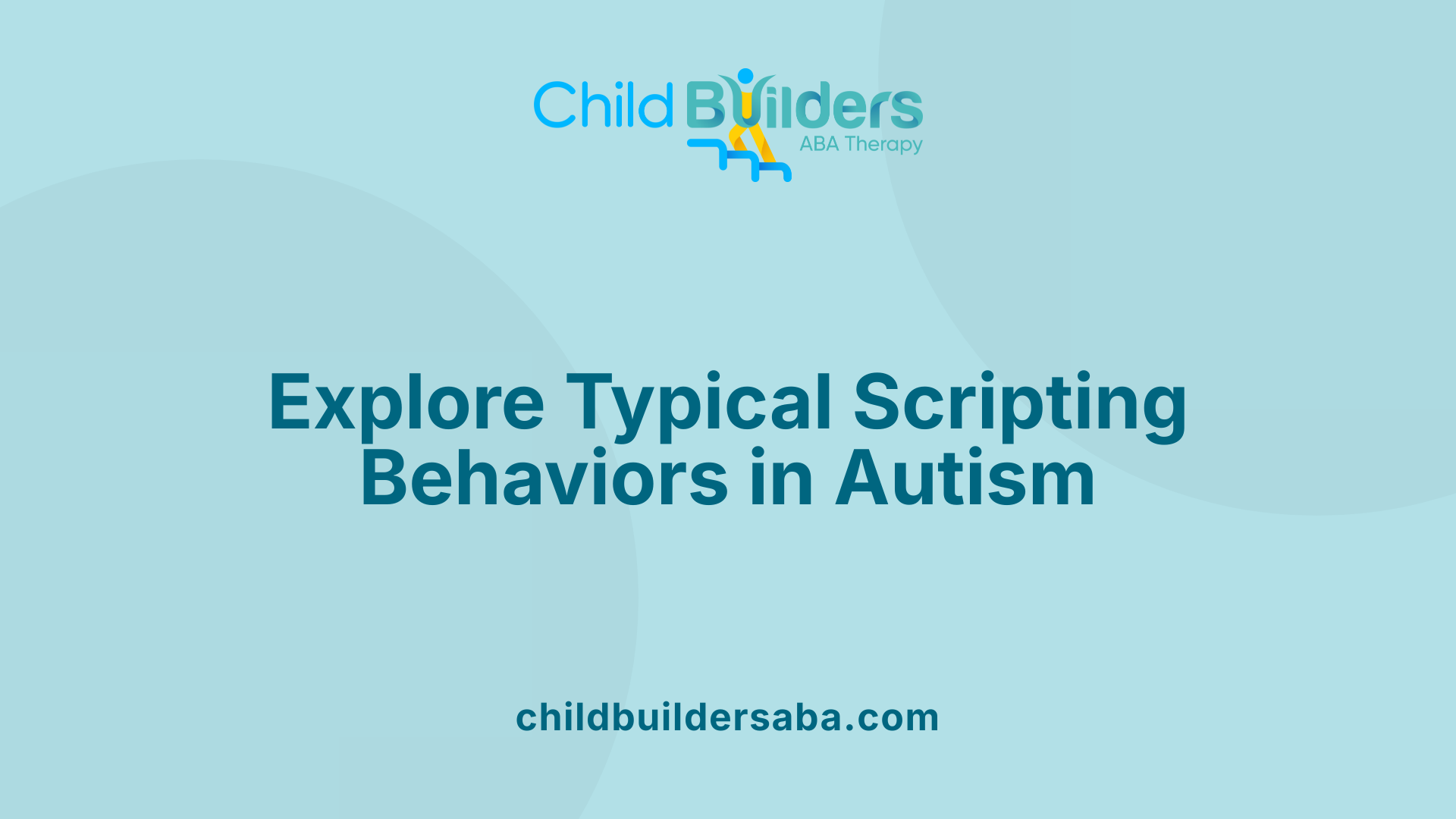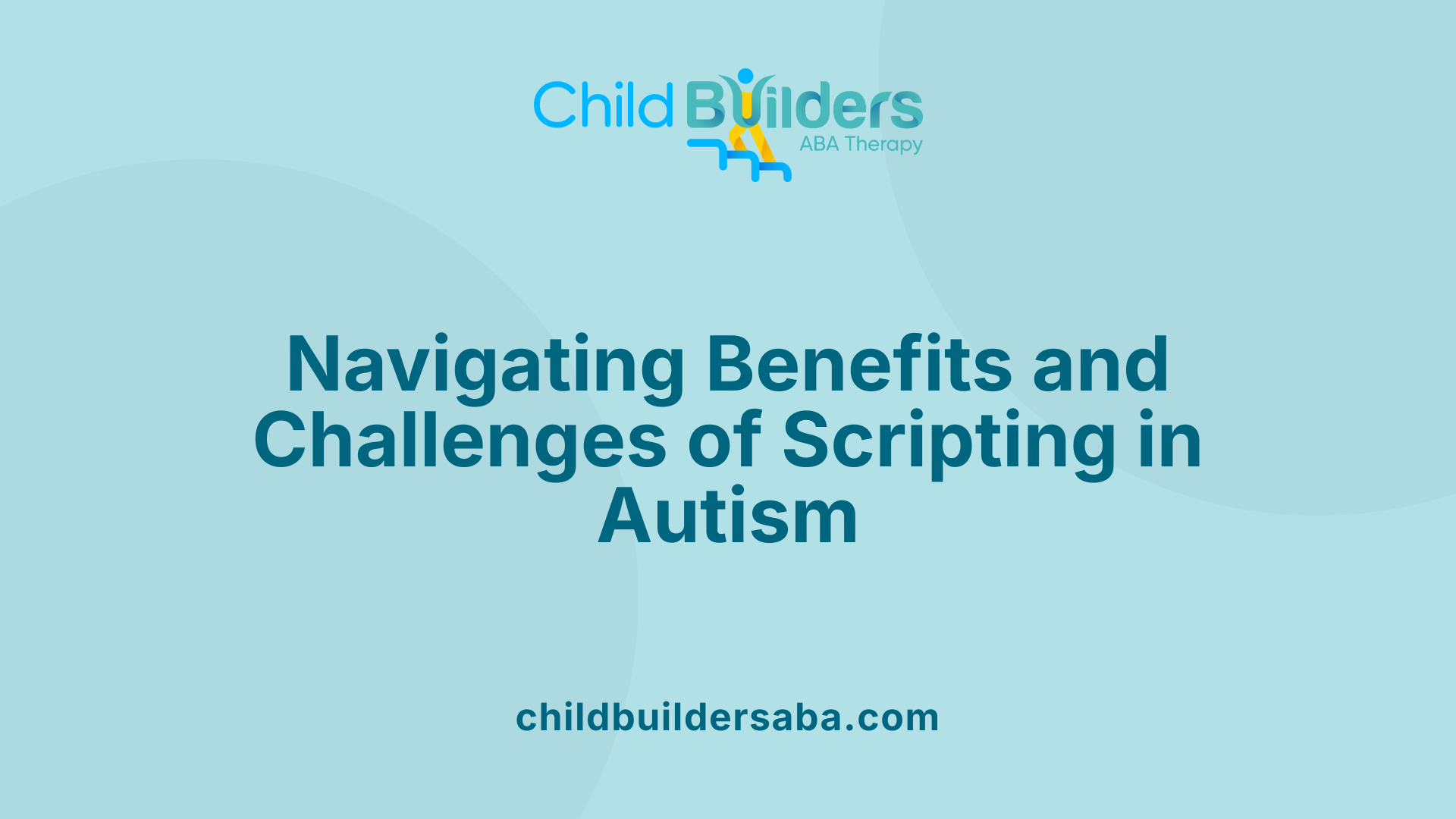What is Autism Scripting?

Deciphering Autism Scripting: An Essential Guide
Autism scripting is a common yet complex behavior observed among individuals with autism spectrum disorder (ASD). It involves the repetition or recitation of words, phrases, or dialogues from media, conversations, or environments. This behavior serves various functions, from facilitating communication to regulating emotions. Exploring the depths of autism scripting reveals its significance in supporting social engagement, understanding its benefits and challenges, and recognizing its role in the broader context of autism.
What is Autism Scripting and Its Origins

What is autism scripting and why do autistic individuals engage in it?
Autism scripting refers to the repeated use of words, phrases, or dialogues that individuals with autism have learned from movies, TV shows, books, or conversations. It involves memorized passages or lines that are recited in various contexts, often as a way to communicate, express feelings, or navigate the world around them.
For many autistic individuals, scripting serves multiple purposes. It can act as a helpful communication tool, especially for those who find spontaneous speech challenging. Scripting provides a predictable way to express needs or share thoughts, which can boost confidence during social interactions. Additionally, it helps with emotional regulation, offering comfort and reducing anxiety in potentially overwhelming situations.
Some use scripting intentionally to facilitate social exchanges, by exchanging familiar lines from media or using scripts as prompts in conversation. Others might do it unconsciously, particularly in the form of echolalia, which involves repeating words or phrases immediately or after a delay. This repetition can be a form of self-stimulation, a soothing behavior, or a development stage in language acquisition.
Autistic individuals often script as part of their natural communication style. In some cases, especially among those who process language in larger chunks or phrases—known as gestalt language processors—scripting becomes a primary way to learn and use language.
Support strategies for scripting include speech therapy and naturalistic, play-based approaches aimed at gradually encouraging spontaneous speech and more flexible communication. Embracing scripting as a meaningful part of an individual's communicative repertoire allows for a more positive understanding of autism, viewing scripting not just as a symptom or disorder but as a functional and resourceful skill.
How is scripting different from echolalia?
While both scripting and echolalia involve repeating words or phrases, they are distinct in purpose and complexity. Echolalia is the immediate or delayed repetition of sounds or words heard elsewhere, often without much context. It can be automatic and is sometimes used as a self-stimulatory behavior.
Scripting, on the other hand, involves the intentional or habitual use of memorized dialogue from media or conversations. It usually follows some level of understanding of dialogue structure and is often context-specific, used to fulfill particular social or emotional needs. Scripting may be more elaborate, involving extended conversations or character roles, whereas echolalia tends to be more repetitive and less context-driven.
Developmental aspects of scripting
Scripting typically emerges as a developmental stage in many autistic children, particularly for those who process language in larger chunks. It often begins early in language development, especially when children memorize lines from their favorite movies, TV shows, or stories.
Over time, children may script less as they acquire more spontaneous speech, yet scripting can persist lifelong for some individuals. It acts as both a stepping stone in language learning and a coping mechanism. For some, scripting may be how they initially understand social rules or how they manage stress.
Support from speech-language therapy aims to help children transition from reliance on scripted language to more spontaneous and flexible communication. This developmental process recognizes scripting as a valuable skill that can be guided and expanded upon to enhance overall social and language abilities.
| Aspect | Description | Additional Notes |
|---|---|---|
| Purpose | Facilitates communication, emotional regulation, and social interaction | Can be intentional or habitual |
| Difference from Echolalia | Echolalia involves immediate or delayed repetition of sounds or words, often automatic | Scripting involves memorized, often media-based dialogue |
| Developmental Role | A natural stage in language learning for many autistic children | Can be a lifelong communication strategy |
| Support Strategies | Speech therapy, naturalistic approaches, social skills groups | Focus on fostering spontaneous speech |
| Cultural Significance | Recognized as part of autistic culture and communication style | Supports self-expression and identity |
Functions and Purposes of Scripting in Autism

Why do autistic individuals engage in scripting?
Autistic individuals often use scripting as a way to communicate, connect socially, and manage their emotions. Scripting involves repeating lines from movies, TV shows, books, or conversations, which can serve as a reliable way to express themselves when spontaneous speech is challenging.
One of the primary reasons for scripting is to facilitate communication. When children or adults script, they access memorized phrases that help them respond in conversations or social settings, making interactions smoother and less overwhelming.
Scripting also supports social interaction by providing familiar and predictable exchanges, which can help reduce anxiety in social situations. It creates a sense of control, making it easier to join conversations, initiate play, or participate in group activities.
Beyond communication and social benefits, scripting plays a vital role in self-regulation and emotional comfort. Many autistic individuals find joy or soothing in reciting their favorite dialogues, which helps them calm down or self-stimulate in a way that feels safe.
Another important aspect is language development. Repeating and memorizing phrases helps build vocabulary, learn sentence structures, and understand how language works. It provides opportunities to practice language skills in a contextual and meaningful way.
Overall, scripting is not just repetitive chatter but a resourceful tool that enhances social bonds, aids in emotional regulation, and supports language learning, making it an integral part of many autistic individuals' lives.
Common Examples of Scripting Behaviors

What are some examples of scripting behaviors in autism?
Autistic individuals often exhibit scripting behaviors, which involve repeating lines or phrases from familiar sources such as movies, TV shows, books, or conversations. This form of communication, also called echolalia, can occur immediately after hearing something or after a delay, sometimes weeks or months later. For example, a child might recite a favorite movie dialogue during playtime or repeat a cereal commercial slogan when asked about breakfast.
Scripts from media are common, with children memorizing and reciting entire scenes or dialogues from their favorite shows or cartoons. These lines might be used in specific social situations, like greeting someone with a familiar phrase, or during emotional moments to express feelings that are difficult to verbalize.
Apart from media, kids may adopt scripted routines for daily interactions — greeting teachers, requesting objects, or saying goodbye — all based on repetitious, familiar phrases. These scripted responses offer comfort and predictability, helping the child manage anxiety or sensory overload.
Scripting is not generally spontaneous speech. Instead, it provides a reliable way to communicate or fulfill social expectations. It can also serve as a means of self-stimulation and sensory regulation, bringing enjoyment and soothing sensations.
While helpful, excessive scripting can sometimes hinder natural conversation and make social interactions challenging. It may mask underlying traits, especially in girls and women, making diagnosis difficult. Support strategies, such as gradually encouraging more spontaneous speech and reducing dependence on scripts, aim to foster more natural communication skills.
In summary, examples include reciting movie lines at specific moments, employing scripted greetings or responses, memorizing phrases for emotional comfort, and using repeated media dialogues during social or emotional contexts. These behaviors reflect the child’s way of understanding and engaging with the world around them, often providing a sense of control and predictability.
Supporting and Managing Scripting in Autism

What is the purpose of scripting?
Scripting is a common behavior among children with autism that serves multiple functions. It helps them navigate social situations by providing familiar and predictable language cues. Many kids use scripting to express feelings, manage anxiety, or cope with sensory overstimulation. Since scripting involves repeating lines from movies, TV shows, books, or conversations, it offers comfort through predictability and a sense of control.
For some children, scripting acts as a way to communicate thoughts and needs more easily, especially if spontaneous speech is limited. It also helps build social connections by allowing children to engage in shared interests like favorite shows or movies. In this way, scripting can be a valuable learning tool, helping children understand sentence structures and expand their vocabulary.
However, scripting differs from spontaneous speech. While it can appear as rigid or repetitive, it often reflects how children process and learn language in large chunks, a trait common among gestalt language processors. Understanding this purpose allows caregivers and professionals to support children effectively, recognizing scripting as a functional and meaningful part of their communication.
What strategies can be used to support and manage scripting behaviors in autism?
To support children who script, it’s important to grasp the function of their scripting behaviors. Once understood, intervention can be personalized and effective. Use visual supports, such as social stories, schedules, and visual cues, to teach appropriate contexts for scripting. These tools help children differentiate when it’s suitable to use scripting and when to try other forms of communication.
Offering choices during interactions, like selecting preferred activities or topics, encourages children to practice spontaneous language. Narratives about daily routines or ongoing activities also give children opportunities to use their words creatively and flexibly.
In addition to support, reinforcement plays a key role. When children attempt spontaneous speech, providing high-value rewards like praise or preferred items can motivate them to use their own words. Response interruption and redirection techniques gently guide children toward more functional communication by encouraging them to express their needs through natural speech.
Fading strategies are also effective. These involve gradually reducing the prompts or scripts used, encouraging independence. For example, starting with full scripts and slowly shifting toward prompts that suggest children finish their own sentences or respond with original words. Combining these approaches creates a supportive environment where scripting is seen as a stepping stone toward more spontaneous language.
How can fading techniques and reinforcement support language development?
Fading is a systematic approach to decrease dependence on scripted language, fostering more spontaneous communication. It involves gradually removing prompts or cues that encourage scripting, while reinforcing any effort to use original language.
Positive reinforcement—such as verbal praise, tokens, or preferred activities—strengthens attempts at spontaneous speech. For instance, if a child responds with their own words instead of a script, praise them enthusiastically to encourage continued effort.
This process must be tailored to each child's needs, recognizing that scripting can be both helpful and persistent. Consistent practice and patience are vital, as well as structured routines that gradually introduce opportunities for spontaneous language.
In therapy settings, fading techniques are often combined with visual supports, modeling, and naturalistic teaching strategies. The goal is to make spontaneous communication a natural and rewarding part of everyday life.
How can we encourage spontaneous language and social skills?
Promoting spontaneous language involves creating opportunities during interactions where children feel safe and motivated to speak freely. Using choice-based activities, open-ended questions, and ongoing narration invites children to produce original responses.
Modeling appropriate language and social behaviors provides a template for children to imitate. Peer-mediated activities, social stories, and video modeling are effective tools that showcase social norms and conversational skills.
Encouraging role-play and pretend scenarios also foster creativity and spontaneous dialogue. Reinforcing any attempt at independent communication, no matter how small, builds confidence and motivates children to engage more naturally.
Supporting social skills can be enhanced by structured social skills groups, where children practice turn-taking, sharing, and other interactions in a supportive environment. Therapists may use social stories to prepare children for real-life situations,
Additionally, reducing reliance on scripting by introducing alternative strategies—such as using pictures, gestures, or assistive communication devices—baves the way for more flexible and authentic interactions.
In conclusion, understanding and effectively managing scripting involves balancing support with opportunities for growth. By employing visual supports, reinforcement, fading techniques, and encouraging spontaneous communication, caregivers and professionals can help children develop more versatile language skills while respecting their unique ways of communicating.
Benefits and Challenges of Autism Scripting

What are the benefits and challenges of autism scripting?
Scripting is a common practice among autistic individuals, bringing both advantages and some difficulties. On the positive side, scripting greatly enhances communication and social skills. For many, it provides a structured way to express needs, feelings, and thoughts, especially when spontaneous speech or social responses are challenging. Scripts from movies, TV shows, or familiar phrases can serve as quick responses during social situations, helping individuals participate more easily and confidently.
Moreover, scripting offers comfort and emotional regulation. Repeating familiar lines can soothe anxiety, serve as a form of self-stimulation, or help manage sensory overload. When faced with unpredictable social environments, having a set of prepared phrases offers predictability and reduces feelings of uncertainty.
Besides emotional benefits, scripting can act as a stepping stone for language development. It allows individuals to practice sentence structure, expand vocabulary, and improve their ability to respond in conversations. Some use scripting intentionally to initiate play, join social groups, or connect with peers.
However, challenges are also associated with scripting. When used excessively, it can interfere with spontaneous language and natural social interactions. Autistic individuals might become overly reliant on scripts, making conversations feel less genuine or flexible. This can lead to difficulties in developing original communication skills and may cause frustration or feelings of loss of personal identity.
Masking symptoms through scripting, especially in girls and women, is another concern. While it may help blend into social settings and reduce stigma temporarily, prolonged masking can be exhausting and lead to burnout or emotional fatigue. It might also delay diagnosis or the recognition of autism traits, hindering access to tailored support.
Balancing scripting with spontaneous speech is crucial. Support strategies include encouraging flexible language use, gradually fading reliance on scripts, and fostering natural interactions through modeling and social stories. Therapies such as speech-language therapy and social skills training can support this balance.
In summary, scripting can be an effective and supportive communication tool when used mindfully. It offers structure, emotional comfort, and opportunities for social engagement, but it requires careful management to promote genuine, spontaneous language and avoid dependence that might hinder personal growth or well-being.
Distinguishing Scripting from Echolalia and Its Significance

What is the difference between echolalia and scripting?
Echolalia is the repetition of words or phrases that someone has heard before. It can happen immediately after hearing the words or later, even weeks or months afterward. The main purpose of echolalia can be to process language, provide self-stimulation, or simply because the individual enjoys the pattern of speech.
Scripting, on the other hand, is a more goal-directed form of repetition. It involves reciting specific lines or dialogues from movies, TV shows, books, or previous conversations. These scripts are often memorized in advance and used intentionally in social settings or emotional situations.
While echolalia is often seen as a natural developmental stage, particularly in young children, scripting tends to be more structured and contextually appropriate. The distinction is important because scripting usually serves a specific function, such as communication support or anxiety reduction, while echolalia may not always have an explicit purpose.
How is autism scripting different from echolalia?
Autism scripting is characterized by the purposeful and contextual use of memorized phrases or lines. For example, a child may recite a line from a favorite movie during a conversation to express themselves or to feel more comfortable. This use can be intentional, to help initiate interactions, or to manage emotional states.
Echolalia, in contrast, involves either immediate or delayed repetition without necessarily aiming for a particular social outcome. It can be more stereotypic or automatic, not always tailored to the situation.
Scripting often involves longer, more complex dialogues and can be integrated smoothly into conversation, sometimes even mimicking speech patterns or mannerisms of characters. It can be a sign of strong memory skills and an organized way for autistic individuals to communicate or soothe themselves.
Understanding this difference helps caregivers and professionals support these behaviors positively. Encouraging purposeful scripting while guiding individuals toward spontaneous speech can promote more natural communication skills.
What are the implications for intervention and support?
Knowing whether a child's behavior is scripting or echolalia informs the choices in therapy and support strategies. If scripting is used to facilitate communication or reduce anxiety, interventions such as speech therapy, social skills training, or behavioral techniques can help expand the child's expressive language.
Support strategies include prompting spontaneous responses, fading scripts gradually, and reinforcing original language development. Supporting scripting as a functional behavior allows for a positive framing rather than viewing it as merely a stereotypic or problematic behavior.
In the case of echolalia, approaches may focus more on understanding its communicative purpose and gradually encouraging more flexible, spontaneous speech. Therapists may use modeling, visual supports, or social stories to help transition from automatic repetition to natural conversation.
A comprehensive support plan recognizes the value of scripting as part of communication development. Embracing and guiding these behaviors can promote confidence, social engagement, and emotional regulation.
How does understanding these behaviors impact social interaction?
Both scripting and echolalia serve important roles in the social lives of autistic individuals. Scripting can serve as a bridge to social interaction, helping children initiate conversations, join group activities, or express feelings.
Parents and caregivers who understand the purpose behind scripting can better support their children by engaging in natural, playful interactions. For example, they might respond with complementary lines or gently encourage original responses.
In this way, support is not about stopping scripting but about harnessing its strengths and gradually fostering spontaneous, versatile communication skills. Recognizing scripting as a resource allows for more tailored and respectful support, boosting social confidence and community participation.
| Aspect | Echolalia | Scripting | Source of Speech | Function | Social Use | Developmental Stage | Typical Age | Flexibility | Support Strategies |
|---|---|---|---|---|---|---|---|---|---|
| Nature | Automatic, immediate or delayed | Purposeful, rehearsed | Heard or memorized | Processing, self-stimulation, communication aid | Initiate conversation, emotional regulation | Early childhood, lifelong | Varies, often during school age | Less flexible, often context-specific | Fading, modeling, visual supports |
Understanding these behaviors better helps in creating supportive environments where autistic individuals can communicate effectively and comfortably. Emphasizing acceptance and strategic guidance rather than correction promotes respectful and meaningful interactions.
Educational and Support Options for Autistic Scripters

What educational and support options are available for individuals who engage in scripting?
For children and adults who frequently use scripting as a form of communication, tailored educational and support strategies can make a significant difference. One primary approach is speech-language therapy, which often involves naturalistic, play-based methods. These therapies aim to encourage spontaneous language use, helping individuals gradually move from reliance on scripts to more flexible, creative communication.
Professionals such as speech-language pathologists and occupational therapists work with individuals to develop personalized techniques. These include the use of visual supports—like picture cards and visual schedules—that help organize thoughts and guide conversations. Structured practice sessions also support learning, where scripts are introduced in specific scenarios such as social storytelling or role-playing exercises.
Integrating social scripting into therapy sessions allows children to rehearse common situations—like greeting peers, requesting items, or participating in group activities—in a controlled, supportive manner. This helps them build confidence and expand their communication skills.
Creating a supportive environment is crucial. Spaces should reduce sensory overload, which can be a trigger for scripting as a self-regulation strategy, and instead foster positive social interactions. Caregivers and educators are encouraged to understand scripting as a meaningful form of expression and coping.
One effective teaching method involves modeling appropriate language and gradually expanding on the scripts children use. For example, if a child recites a line from a TV show, an adult might respond by expanding the dialogue or prompting the child to create an original sentence, encouraging flexibility.
Promoting adaptability also includes teaching social skills through the use of social stories and functional scenarios. These tools help children navigate complex social interactions by practicing specific language patterns and expectations.
Overall, these supports aim to help individuals leverage their scripting for better communication, social participation, and emotional regulation. By fostering an environment of patience, creativity, and understanding, caregivers and professionals can guide script users towards more spontaneous, meaningful interactions—ultimately supporting their growth into independent and confident communicators.
Embracing and Supporting Autism Scripting
Recognizing and understanding autism scripting as a meaningful part of communication can open pathways for better support and integration. It highlights the strength and resourcefulness of autistic individuals in navigating social worlds. Support strategies that foster flexible and spontaneous speech, alongside acceptance of scripting as a valid expression, can help individuals develop more fluid communication skills and reduce reliance on rigid behaviors. Embracing scripting within a supportive framework not only promotes language and social development but also celebrates the diversity of autism as a unique form of expression.
References
- What is "Scripting"? : A Guide for Parents of Kids with Autism ...
- What Is Autistic Scripting? - Choosing Therapy
- Autism Scripting Can Help Children Build Language Skills - Blue ABA
- What is autism scripting? - MentalHealth.com
- Autism Scripting | Private Therapy Clinic
- Scripting - Autism Hub
- Introduction to Echolalia and Autistic Scripting | Neurodiverging
- Autism Scripting: 4 Steps to Manage It
- What is "Scripting"? : A Guide for Parents of Kids with Autism ...
- Autism Scripting Can Help Children Build Language Skills - Blue ABA





.jpg)































































































